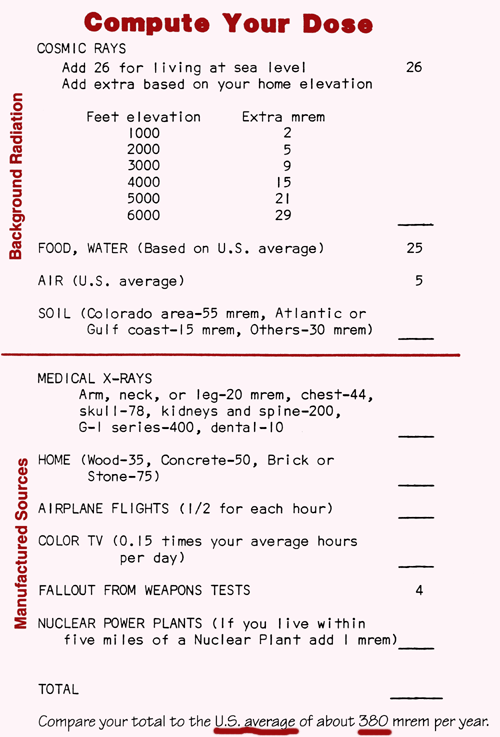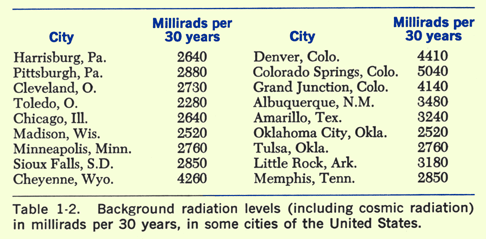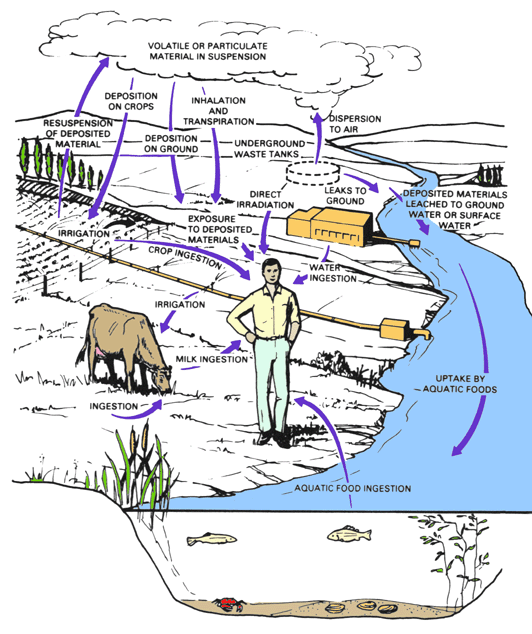
Background Radiation: A slippery slope which slides up whenever the nuclear industry slips up.
In The Effects of Nuclear Weapons (Department of the Air Force, 1957, 1962), the lifetime radiation dose from "natural sources" is given as 10 rem (10,000 mrem).
A 1973 book titled Nuclear Energy: Its Physics and its Social Challenge (by David Rittenhouse Inglis, Addison-Wesley Publishing, page 130), Table 5-1: Radiation Exposure in the United States, gives radiation as 193.2 mrem per year: 126.0 mrem from "natural sources" and 67.2 mrem from "man-made" sources. The table was based on the 1963 report of the Federal Radiation Council and adapted from I. Asimov and T. Dobzhansky, Ref. 6.
In 1976, the average "natural" background radiation was 88 mrem a year, according to a March 8th, 1976 EPA report by Gertrude Dixon (referred to in NO NUKES, by Anna Gyorgy & Friends (1979, page 80)).
In 2002, the average background radiation dose in America is claimed to be about 320 mrem to 360 mrem; about half of this (160 mrem to 180 mrem) is said to be from "natural" sources, at least in San Diego County where this writer lives, as published in the local North County Times.
In the following document, I've underlined the indication of 380 mrem as the U. S. average background dose.

-- The above "do it yourself" dose calculation form is from: Atomic Energy, Boy Scouts of America, Merit Badge Series, page 37, Irving, TX, 1998 printing of the 1983 edition. (Colorized and underlined by this author.)
According to the University of Michigan, in 2002, "in the United States, the annual estimated average effective dose equivalent is 360 mrem per adult". Fully 300 mrem of this total is due to natural sources, according to them, and only 60 mrem is from "artificial" sources:
| Source | Average annual effective dose equivalent | |
|---|---|---|
| (µSv) | (mrem) | |
| Inhaled (Radon and Decay Products) | 2000 | 200 |
| Other Internally Deposited Radionuclides | 390 | 39 |
| Terrestrial Radiation | 280 | 28 |
| Cosmic Radiation | 270 | 27 |
| Cosmogenic Radioactivity | 10 | 1 |
| Rounded total from natural source | 3000 | 300 |
| Rounded total from artificial Sources | 600 | 60 |
| Total | 3600 | 360 |
Shown in the table above, 82% of the total average annual effective dose is from natural sources of radiation, and of that, most is from radon. Of the other 18%, the majority is from medical diagnosis and treatments, with <1% from nuclear power and fallout.
The above table and quote is from: http://www.umich.edu/%7Eradinfo/introduction/natural.html
----------------------------------------------------------

-- Above image is from: Radiation, Genes, and Man: Biological Aspects of Radiation Hazards, by Bruce Wallace, & Th. Dobzhansky, Holt, Rinehart, and Winston, New York, 1963. (Colorized by this author.)
----------------------------------------------------------
How is an illustration of some of the pathways for radionuclides from the nuclear industry to your body:

-- Above image is from: Understanding Radioactive Waste, Third Edition,by Raymond L. Murray, page 98, Battelle Press, OH , 1989. (Colorized by this author.)
----------------------------------------------------------
Background radiation has NOT been increasing. In fact, it was slowly decreasing prior to 1945:
"I'll be philosophical. Until about 2 billion years ago, it was impossible to have any life on earth. That is, there was so much radiation on earth you couldn't have any life — fish or anything. Gradually, about 2 billion years ago, the amount of radiation on this planet reduced and made it possible for some form of life to begin — it started in the seas, I understand from what I've read. And that amount of radiation has been gradually decreasing because all radiation has a half-life, which means ultimately there will be no radiation. Now, when we go back to using nuclear power, we are creating something that nature tried to destroy to make life possible." — Admiral Hyman Rickover, known as the father of the Nuclear Navy (a man who was filled with regret by the end of his life).
-- Above quote was from: The Nuclear Fix, by Thijs De La Court, Deborah Pick, & Daniel Nordquist, WISE, page 1, 1982 (the reference is attributed to "the Godfather of Nuclear Power, 1982").
----------------------------------------------------------
But what difference does a little radiation make? That's what the world wants to know and needs to know! Under the glossary entry "health effects", you'll see two graphic illustrations of the difference of opinion among experts -- the "area of controversy".
Here is a quote which describes this same difference of opinion:
"There is little question about the type of damage caused by exposure to plutonium; lung, bone, and liver cancer and leukemia are the most frequently occurring serious results of exposure. The magnitude of the risk at small doses is less certain, however. Estimates of the dose needed to case lung cancer differ by as much as a factor of a thousand. At the high end of the range, many tens of thousands of cancers worldwide may have been caused by atmospheric testing of nuclear weapons. At the low end, the risk to the public may be negligible. Even those who accept the low risk estimate, however, agree that up to 30 deaths from cancer resulted from the fire at Britain's Windscale plutonium production plant, which exposed the general population living nearby the plant, as well as plant workers.
"Believers of either of the extreme estimates will not be easy to convince that the other extreme is correct. In such an uncertain situation, it is tempting for those not polarized on the issue to assume that the truth lies somewhere in the middle. But this may not be the case: the true risk may actually be one or the other of the extreme views."
--The above quote is from: Toxics A to Z: A Guide to Everyday Pollution Hazards, by John Harte, Cheryl Holdren, Richard Schneider, and Christine Shirley, Univ. of Calif. Press, CA, 1991.
There are a number of postscripts to the Toxics A to Z quote shown above. Since it was published in 1991, more than ten thousand people have been deemed worthy of federal payments as "downwinders". And at some point, Windscale changed its name to Sellafield. But it's the same old place, still killing the people who live around it, and more than a few of the rest of us, too.
----------------------------------------------------------
It is the belief of this author that there is now little reason to doubt that the low estimate is little more than WHIMSY on the part of the Nuclear Industry and its supporters. Low Level Radiation is very dangerous, and the Nuclear Industry is GUILTY of cover-up, of lying, of ignoring reality, of dereliction of duty, of gross negligence, of manslaughter, of murder, and of genocide. And of being in a hurry to do something that, in hindsight, was way over their heads.
Sure, the engineering ideas work in principle. But not in reality. Not in today's "threat environment". They couldn't build them well enough, and they didn't build them well enough.
The 430 nuke plants around the world are destroying the planet, creating an uncontrollable, deadly mess, and they must ALL be shut down. We owe it to our children and we owe it to ourselves.
Copyright (c) 2002 by Russell D. Hoffman. All Rights Reserved